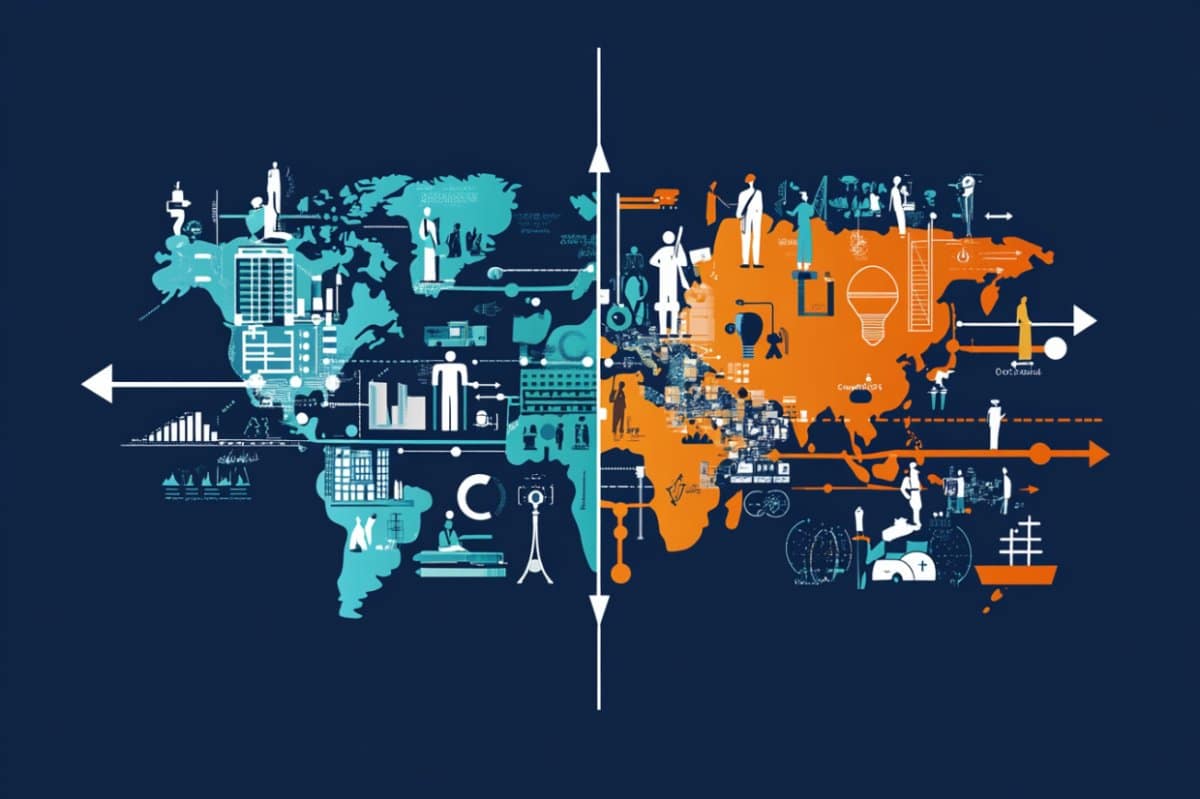Summary: A recent study overturns the conventional idea that skilled emigration harms developing countries by showing it can actually enhance economic development and innovation. Researchers found that when people have the opportunity to migrate to higher-income countries like the U.S., it motivates greater educational investment in their home countries.
Migrants often maintain cross-border professional ties that support trade, business, and knowledge exchange. The effects are measurable: in the Philippines, visa expansions for nurses led to a dramatic increase in nursing school enrollment; in India, more H-1B visas boosted local tech sector employment.
Key Facts:
- Migration Spurs Education: Migration incentives increase education and training in source countries.
- Global Economic Ties: High-skilled migrants foster trade, innovation, and supply chain links with their home countries.
- Policy Implications: Restrictive U.S. immigration policies could undermine both American innovation and global development.
Source: UCSD
As the national debate intensifies around immigration, a new study from the University of California School of Global Policy and Strategy is challenging conventional wisdom about “brain drain”—the idea that when skilled workers emigrate from developing countries, their home economies suffer.
Published in Science, the paper reveals high-skilled emigration from developing countries may actually boost economic development, human capital and innovation in migrants’ countries of origin.

With the U.S. undergoing sweeping immigration policy shifts—which include tighter work visa rules, student visa restrictions and return migration barriers—the new research highlights how these changes will reverberate through the U.S. labor market and economies around the world.
“Global prosperity rises when countries have access to U.S. labor markets,” said Gaurav Khanna, study coauthor and associate professor at the UC San Diego School of Global Policy and Strategy. “And the U.S. benefits when it continues to attract the best global talent — whether it’s tech innovators or trained nurses. But if we shut the door, we risk losing those global gains.”
Migration creates shared prosperity across borders
The research offers compelling evidence that the opportunity to migrate to countries like the United States encourages people in lower-income countries to invest in education and training, creating downstream effects that strengthen both home and host countries.
The researchers also found that high-skilled migrants often maintain professional ties across borders, facilitating trade, investment and innovation. Migrants returning from the U.S. to their home countries, for example, have helped connect domestic firms to international supply chains and research partnerships.
“A lot of trade works through human networks,” said Khanna. “If you’ve worked in the U.S. and return home, you know the people, the standards, the markets — and you can help build business relationships. That creates lasting value.”
A global chain reaction
The paper documented how expanded migration opportunities can trigger a positive chain reaction. When the U.S. increased nursing visa access for Filipinos, for example, enrollment in nursing schools surged — creating nine new nurses in the Philippines for every one who migrated. Similar trends were observed in India, where increased access to H-1B visas increased the earnings of Indians in the U.S. by 10% and raised IT employment in India by 5.8%.
Khanna and coauthors from Yale, Cornell, the World Bank, and other institutions, argue that recent changes in U.S. immigration risk undercutting both U.S. innovation and global progress.
“Earning a U.S. salary is incredibly lucrative,” said Khanna, who is a faculty affiliate at the 21st Century India Center, explained.
“That motivates many people to acquire skills even if they never leave. Some eventually return home and work in their local economy; others send money back that helps educate children or launch businesses. All of this contributes to development. And for the U.S., by staying open to global talent, the country strengthens both its economy and the broader world.”
To understand whether high-skilled emigration helps or harms the countries people leave behind, the authors reviewed dozens of recent studies that took advantage of natural experiments.
These include sudden changes in visa policies, international lotteries and other real-world events. The authors then analyzed how people and economies changed in response to these events — and compared them to similar groups that weren’t affected.
About this neuroscience and psychology research news
Author: Christine Clark
Source: UCSD
Contact: Christine Clark – USCD
Image: The image is credited to Neuroscience News
Original Research: Closed access.
“Brain drain or brain gain? Effects of high-skilled international emigration on origin countries” by Gaurav Khanna et al. Science
Abstract
Brain drain or brain gain? Effects of high-skilled international emigration on origin countries
BACKGROUND
Emigration rates are in the range of 10 to 50% for highly skilled individuals such as top academics, inventors, scientists, engineers, and medical professionals from many lower-income and smaller countries. There have long been concerns that this “brain drain” harms origin economies.
However, high-skilled migration can also enhance human capital at home through “brain gain” effects on incentives to invest in education, remittances, and return migration. Additionally, it can have other beneficial impacts on well-being in the origin country through trade and business development, innovation, and transmitting knowledge and positive norms from the destination.
ADVANCES
Much of the debate around brain drain and gain has relied on theoretical arguments, anecdotes, and noncausal empirical associations. Recent research has used modern experimental and nonexperimental methods to establish causal evidence on these different channels.
We now have empirical validation of the theoretical argument that new high-skilled migration opportunities can increase, rather than decrease, the overall stock of educated workers in a country.
Exogenous changes in US immigration policies resulted in more Filipinos training as nurses and more Indians acquiring computer science skills than the people emigrating, raising the total number with these skills at home (see summary figure). Human capital at the origin also increases through remittances funding education and from migrants returning with education and work experience acquired abroad.
Whether the net effect is a brain drain or gain will depend on fundamental factors such as how quickly universities and training institutes can adjust to produce the skilled workers demanded abroad given the regulatory environment for higher education, or the conditions governing investments at home.
Other impacts on home economies vary with the time frame, type of skill migrating, and country context. There can be short-term negative consequences on firms and scientific innovation in origin countries when skilled workers depart, but over time these emigrants build trade and FDI networks and act as conduits for knowledge transfer.
This can spur the creation of new industries, as has occurred in the IT sector in several countries. Migrants also tend to transfer political attitudes and social norms of their destination countries, which can boost support for democracy, improve population health, and enhance female decision-making power at home when migrants go to more liberal and democratic destinations.
The largest welfare impacts are on the high-skilled emigrants themselves, who often more than double their incomes by migrating. Migration also produces much broader positive impacts on origin communities. Benefits accrue not only to other household members left behind by the migrant, but also to entire regions through the investment, trade, entrepreneurship, and innovation channels described above.
Despite fears of medical brain drain, there is an absence of causal evidence for negative impacts, and population health at home can also improve with emigration as a result of improved norms, remittances, knowledge transfers, and return migration of skilled health professionals.
OUTLOOK
Rising education levels worldwide, international competition for talent, and a preference for high-skilled migrants in many destination-country migration policies are all likely to ensure that the flow of high-skilled migrants from poor to rich countries will continue to grow. Recent literature should provide some reassurance to those concerned about “brain drain” as it demonstrates many potential ways origin countries gain from the outflow.
However, the evidence base remains limited, and there are many opportunities for new causal research. Most research looks at the impact of all types of skilled migration combined, or pools together educated and less-educated migrants, whereas net impacts may vary depending on the type of skill departing.
Much of the literature focuses on impacts in a few large middle-income countries such as India, the Philippines, and Mexico, but outcomes may differ in more fragile and poorer countries that have fewer opportunities for skill acquisition and productive home investments.
Despite these differences, for small, poor origin countries, the existing body of research can help clarify policies that may enable these countries to experience more of the benefits from skilled migration rather than the costs. The biggest research gaps, however, lie in understanding effective policy responses in sending regions.
Comprehensive policy analysis requires a consideration of the full range of direct and indirect “general equilibrium effects” of emigration on all relevant labor markets, and any external benefits accruing to population health and well-being through new innovations and business creation.







